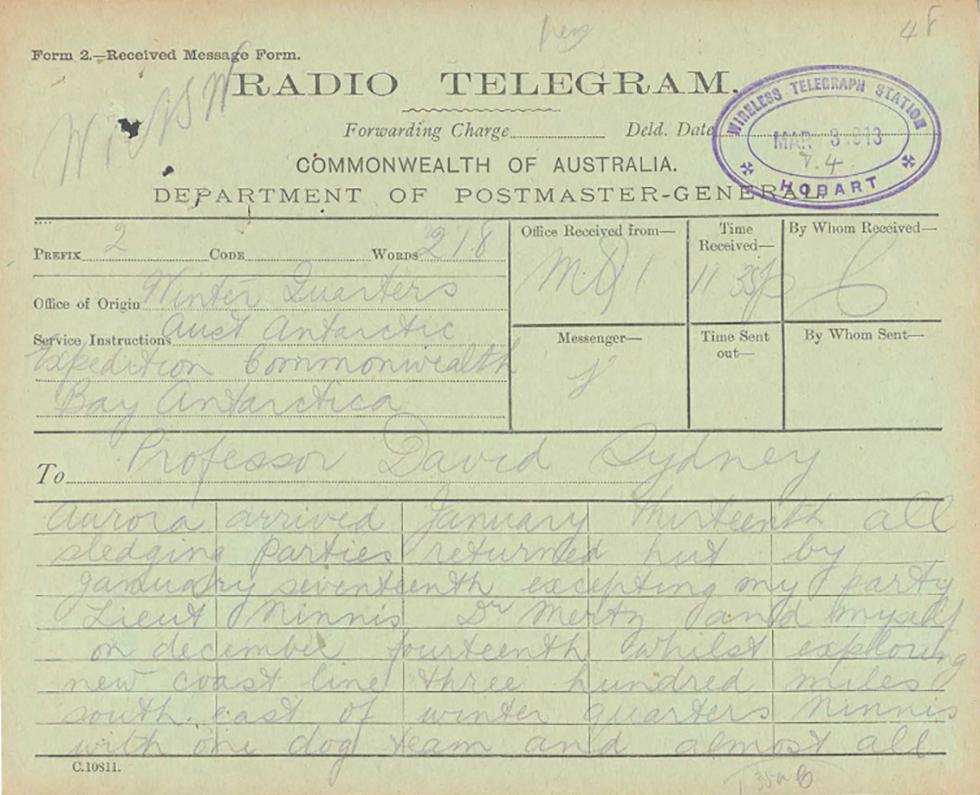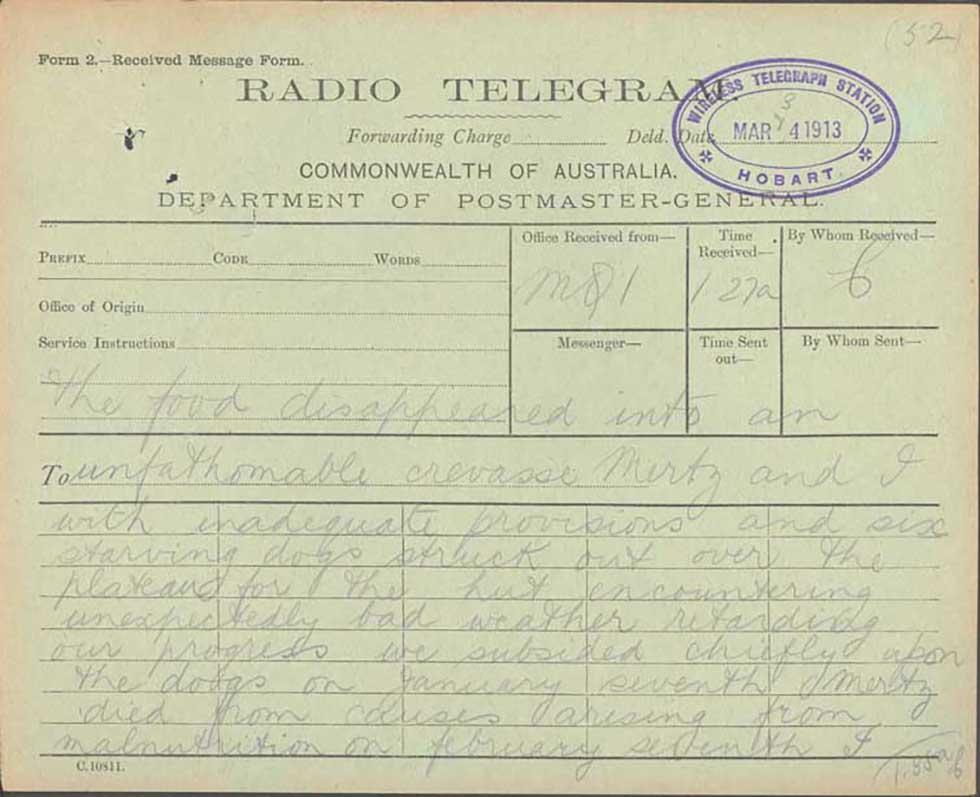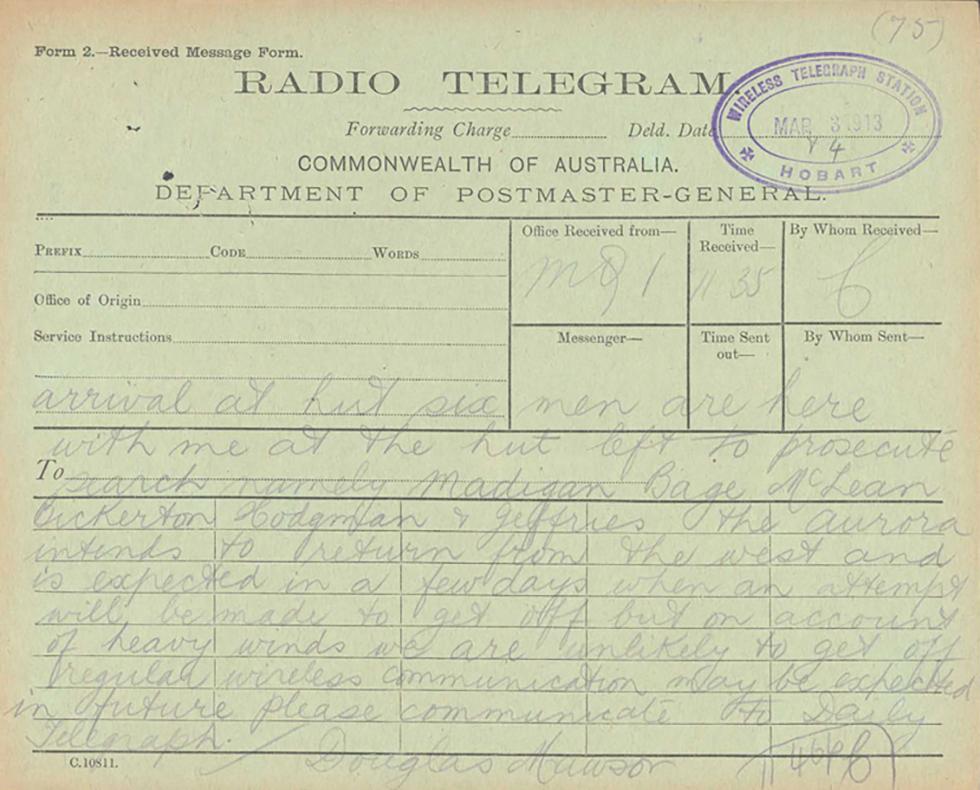


Aboriginal and Torres Strait Islander people should be aware that the National Archives' website and collection contain the names, images and voices of people who have died.
Some records include terms and views that are not appropriate today. They reflect the period in which they were created and are not the views of the National Archives.




Form 2 – Received Message Form.
RADIO TELEGRAM
Forwarding Charge – Deld. Date: Wireless Telegraph Station Mar 3 [1]913 Hobart
COMMONWEALTH OF AUSTRALIA
DEPARTMENT OF POSTMASTER-GENERAL
PREFIX: 2 CODE: WORDS: 218
Office of Origin: Winter Quarters
Service Instructions: Aust Antarctic Expedition Commonwealth Bay Antarctica
Office Received from—MQI [Macquarie Island]
Time Received—1135
By Whom Received—[illegible]
Messenger—[illegible]
Time Sent out—
By Whom Sent—
To: Professor David Sydney
Aurora arrived January thirteenth all sledging parties returned hut by January seventeenth excepting my party Lieut Ninnis Dr Mertz and myself on December fourteenth whilst exploring new coast line three hundred miles south east of winter quarters Ninnis with one dog team and almost all the food disappeared into an unfathomable crevasse Mertz and I with inadequate provisions and six starving dogs struck out over the plateau for the hut encountering unexpectedly bad weather retarding our progress we subsisted chiefly upon the dogs on January seventh Mertz died from causes arising from malnutrition on february seventh I arrival at hut six men are here with me at the hut left to prosecute search namely Madigan Bage Mclean Bickerton Hodgeman and Jeffreys the Aurora intends to return from the west and is expected in a few days when an attempt will be made to get off but on account of heavy winds we are unlikely to get off regular wireless communication may be expected in future please communicate to Daily Telegraph Douglas Mawson.
This radio telegram was written by Douglas Mawson, leader of the Australasian Antarctic Expedition. It was sent from Antarctica to his friend Professor Edgeworth David in Sydney, Australia, on 13 March 1913, and describes the extreme challenges faced by Mawson and his men.
The Main Base of the Australasian Antarctic Expedition (AAE) was established at Commonwealth Bay in January 1912.
In November 1912, exploratory sled expeditions, one of them led by Douglas Mawson, set out from base. Mawson planned for them to be back by 15 January 1913 at the latest. But, when the men were almost 500 kilometres away from the base, one of the men, Belgrave Ninnis, together with a sledge and dog team and many of the supplies, fell down a crevasse and disappeared.
The remaining 2 men battled extreme conditions travelling across uncharted territory as they tried to return to the base. Faced with imminent starvation, they progressively killed and ate their dogs.
After a second man, Xavier Mertz, also died (from exhaustion, and possibly poisoning from eating dogs’ liver), Mawson struggled on alone for almost a month. He finally returned to Main Base on the brink of death with his scientific specimens and records.
In a tragic twist, Mawson discovered that he had missed the expedition’s ship, the Aurora, by hours. The ship had come back to Main Base to collect the sledging party. When the party failed to appear, the captain had delayed the ship’s departure for weeks, putting it at risk of being trapped in ice. Finally, he decided to depart, leaving behind a small rescue party to stay and search for the missing men.
Mawson and the rescue party endured another winter in Antarctica.
Learn how to interpret primary sources, use our collection and more.
